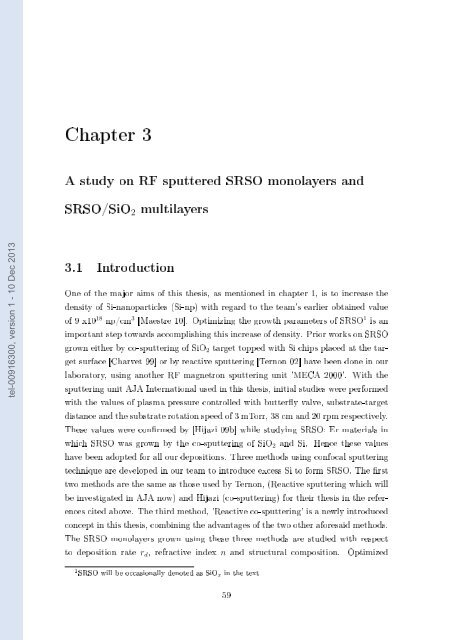Films minces à base de Si nanostructuré pour des cellules ...
Films minces à base de Si nanostructuré pour des cellules ...
Films minces à base de Si nanostructuré pour des cellules ...
Create successful ePaper yourself
Turn your PDF publications into a flip-book with our unique Google optimized e-Paper software.
Chapter 3<br />
A study on RF sputtered SRSO monolayers and<br />
SRSO/<strong>Si</strong>O 2 multilayers<br />
tel-00916300, version 1 - 10 Dec 2013<br />
3.1 Introduction<br />
One of the major aims of this thesis, as mentioned in chapter 1, is to increase the<br />
<strong>de</strong>nsity of <strong>Si</strong>-nanoparticles (<strong>Si</strong>-np) with regard to the team's earlier obtained value<br />
of 9 x10 18 np/cm 3 [Maestre 10]. Optimizing the growth parameters of SRSO 1 is an<br />
important step towards accomplishing this increase of <strong>de</strong>nsity. Prior works on SRSO<br />
grown either by co-sputtering of <strong>Si</strong>O 2 target topped with <strong>Si</strong> chips placed at the target<br />
surface [Charvet 99] or by reactive sputtering [Ternon 02] have been done in our<br />
laboratory, using another RF magnetron sputtering unit 'MECA 2000'. With the<br />
sputtering unit AJA International used in this thesis, initial studies were performed<br />
with the values of plasma pressure controlled with buttery valve, substrate-target<br />
distance and the substrate rotation speed of 3 mTorr, 38 cm and 20 rpm respectively.<br />
These values were conrmed by [Hijazi 09b] while studying SRSO: Er materials in<br />
which SRSO was grown by the co-sputtering of <strong>Si</strong>O 2 and <strong>Si</strong>. Hence these values<br />
have been adopted for all our <strong>de</strong>positions. Three methods using confocal sputtering<br />
technique are <strong>de</strong>veloped in our team to introduce excess <strong>Si</strong> to form SRSO. The rst<br />
two methods are the same as those used by Ternon, (Reactive sputtering which will<br />
be investigated in AJA now) and Hijazi (co-sputtering) for their thesis in the references<br />
cited above. The third method, 'Reactive co-sputtering' is a newly introduced<br />
concept in this thesis, combining the advantages of the two other aforesaid methods.<br />
The SRSO monolayers grown using these three methods are studied with respect<br />
to <strong>de</strong>position rate r d , refractive in<strong>de</strong>x n and structural composition. Optimized<br />
1 SRSO will be occasionally <strong>de</strong>noted as <strong>Si</strong>O x in the text<br />
59
















